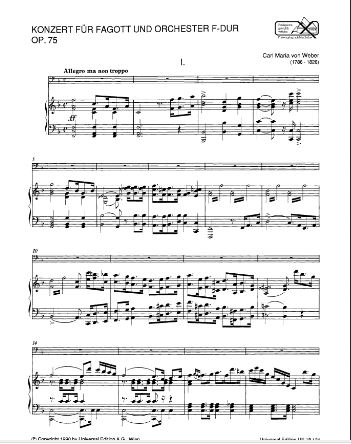
Happy Present Meet
Weber Concerto in F Major Op.75 for Bassoon and Piano
piano reduction: Waterhouse, William
Content text:
1. Satz
Allegro ma non troppo · 2. Satz
Adagio · 3. Satz
Rondo Allegro
Difficulty: advanced
The bassoon concerto by Weber ranks second only to that of Mozart in importance. Since first appearing in print in 1823 it has been republished many times; however the version in which it is generally known today is an anonymously edited one dating from some 40 years after the composer's death which differs in many points of detail from the composer's original. The aim of this edition is to restore Weber's text free of any editorial intervention. Weber, then 25 years old, wrote the work in Munich between the 14th & 27th November 1811 at the request of the bassoonist Georg Friedrich Brandt (1773- 1836). The first performance took place in the Court theatre on December 28th, a fair copy of his score being made for the purpose. Having kept his own score by him for 11 years, Weber gave it in 1822 to his Berlin publisher Schlesinger, who issued it the following year in parts. More experienced now, and having heard Brandt play it in Prague, he took the opportunity to carry out a few revisions, expanding the tuttis here and there and rescoring some of the accompaniments; however he made only few minor alterations to the solo part. The 1823 first edition conforms closely to this revised version.
ln the present edition, the solo part is based on the 1822 revision; a few minor errors and inconsistencies have been corrected, and the 1823 first edition has been referred to throughout. The composer's orthography has been retained, including his disposition of beams & flags, which often subtly seems to indicate phrasing. At first sight Weber appears inconsistent with his markings; it is evident however that, while meticulously marking certain passages, elsewhere he has deliberately left his interpreter free to determine matters of articulation and accentuation according to his own preference and technique. Needless to say, the absence of such marks does not mean that the player does not need to supply them! lt is to be hoped that such passages, free of composer's prescription and editor's suggestion alike, will stimulate the performer's initiative and imagination. (William Waterhouse)
베버의 바순 협주곡은 중요성 면에서 모차르트에 이어 두 번째로 중요합니다. 1823년 처음 출판된 이후 이 책은 여러 번 재발행되었습니다. 그러나 오늘날 일반적으로 알려진 버전은 작곡가가 사망한 지 약 40년 후에 익명으로 편집된 버전으로, 작곡가의 원본과 많은 세부 사항이 다릅니다. 이 판의 목적은 편집자의 개입 없이 베버의 텍스트를 복원하는 것입니다. 당시 25세였던 베버는 바순 연주자 게오르그 프리드리히 브란트(1773~1836)의 요청으로 1811년 11월 14일과 27일 사이에 뮌헨에서 작품을 썼습니다. 첫 공연은 12월 28일 코트 극장에서 열렸는데, 이를 위해 그의 악보가 공정하게 복사되었습니다. 11년 동안 자신의 악보를 보관해 온 베버는 1822년에 이 악보를 베를린 출판사인 슐레진저에게 주었고, 슐레진저는 이듬해에 부분적으로 발행했습니다. 이제 경험이 더 많아졌고 프라하에서 브란트의 연주를 들은 그는 몇 가지 수정 작업을 수행할 기회를 얻었고 여기저기서 투티를 확장하고 일부 반주를 다시 채점했습니다. 그러나 그는 솔로 부분을 약간만 변경했습니다. 1823년 초판은 이 개정판과 밀접하게 일치합니다.
현판에서 독창부는 1822년 개정판을 기초로 하고 있다. 몇 가지 사소한 오류와 불일치가 수정되었으며 1823년 초판이 전체적으로 참조되었습니다. 종종 미묘하게 문구를 나타내는 것처럼 보이는 빔과 깃발의 배치를 포함하여 작곡가의 철자법이 그대로 유지되었습니다. 첫눈에 Weber는 그의 표시와 일치하지 않는 것처럼 보입니다. 그러나 그가 특정 구절을 꼼꼼하게 표시하는 동안 다른 곳에서는 해석자가 자신의 취향과 기술에 따라 발음과 강조 문제를 자유롭게 결정할 수 있도록 의도적으로 남겨두었음이 분명합니다. 말할 필요도 없이, 그러한 표시가 없다고 해서 플레이어가 그것을 제공할 필요가 없다는 의미는 아닙니다! 작곡가의 처방이나 편집자의 제안이 전혀 없는 이러한 구절이 연주자의 주도성과 상상력을 자극할 것으로 기대됩니다. (윌리엄 워터하우스)
작곡가 Weber, Carl Maria Von (1786-1826)
에디터 Turkovic, Milan
Waterhouse, William

[특가상품] Mozart Bassoon Concerto, K.191 for Bass and Piano
Test Pieces for Orchestral Auditions Bassoon / contrabassoon
Weber Andante and Rondo Ungarese in c minor Op.35 for Bassoon and Piano
Mozart Concerto in Bb major K.191 for Bassoon and Piano
Hummel Bassoon Concerto in F major for Bassoon and Piano
[특가상품] Weber Andante and Rondo Ongarese Op.35 for Bassoon and Piano
Rossini Concerto for Bassoon and Piano
Enesco Legend (Trumpet in Bb or C) for Trumpet and Piano